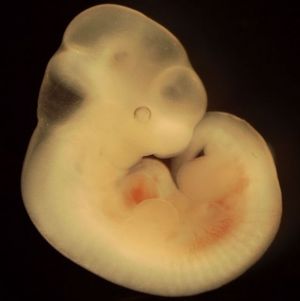Apr. 6, 2007 Research Highlight Biology
Heading in the right direction
Fish and mice provide insight into the evolution of the head
 Figure 1: A mouse embryo. The gene that initiates development of the brain in the mouse can be activated by a zebrafish enhancer, even though the biochemical mechanism differs.
Figure 1: A mouse embryo. The gene that initiates development of the brain in the mouse can be activated by a zebrafish enhancer, even though the biochemical mechanism differs.
RIKEN researchers and colleagues in the US have determined that, with the exception of the bony fishes, the molecular regulators of head development have been deeply conserved during the evolution of vertebrates, the animals with backbones.
On an evolutionary line from primitive skate species through to the mouse, the researchers found that the gene known as Otx2, which directs development of the head region and the brain, is activated at different times and places by at least two distinct enhancers. In the bony fishes or teleosts that branch off this line early on, however, only one of these enhancers is employed.
The head is the structure that has undergone the most change during vertebrate evolution, and its development helps set the body plan for all vertebrates. The work is important because it reinforces suggestions that significant evolution in vertebrates can result not only from changes in genes themselves, but also from subtle variation in the way those genes are regulated.
The regulator conserved in all vertebrates is known as the forebrain/midbrain (FM) enhancer, because it switches Otx2 on at the time of development of that particular region of the head. But in all vertebrates, except for the bony fishes, there is a second regulator in addition to FM. The anterior neuroectoderm (AN) enhancer actives the Otx2 gene at an earlier time than FM to initiate development of what becomes the bulk of the brain in mammals − the cerebellum and hypothalamus.
The researchers from RIKEN's Center for Developmental Biology in Kobe and the Benaroya Research Institute in Seattle, US, recently published details of the activity of the teleost FM enhancer in zebrafish1. They found that this enhancer also takes on the role of the AN enhancer. But the teleost FM enhancer does not use the same mechanism as that of AN in activating Otx2 at the appropriate time. It binds with a different set of compounds to act upon the gene. These compounds are also present in mouse embryos (Fig. 1). And, using transgenic mice, the researchers found that the zebrafish FM enhancer was active in mice and, in the absence of AN, could switch on Otx2.
The researchers also analyzed Otx2 DNA sequences in species of skate and coelacanth, considered to represent an earlier stage of evolution than either mice or zebrafish. These species both carried AN and FM enhancers closely related to those found in mice. So, the researchers infer that this was the ancestral condition.
References
- 1. Kurokawa, D., Sakurai, Y., Inoue, A., Nakayama, R., Takasaki, N., Suda, Y., Miyake, T., Amemiya, C. & Aizawa, S. Evolutionary constraint on Otx2 neuroectoderm enhancers − deep conservation from skate to mouse and unique divergence in teleost. Proceedings of the National Academy of Sciences USA 103, 19350-19355 (2006). doi: 10.1073/pnas.0604686103
